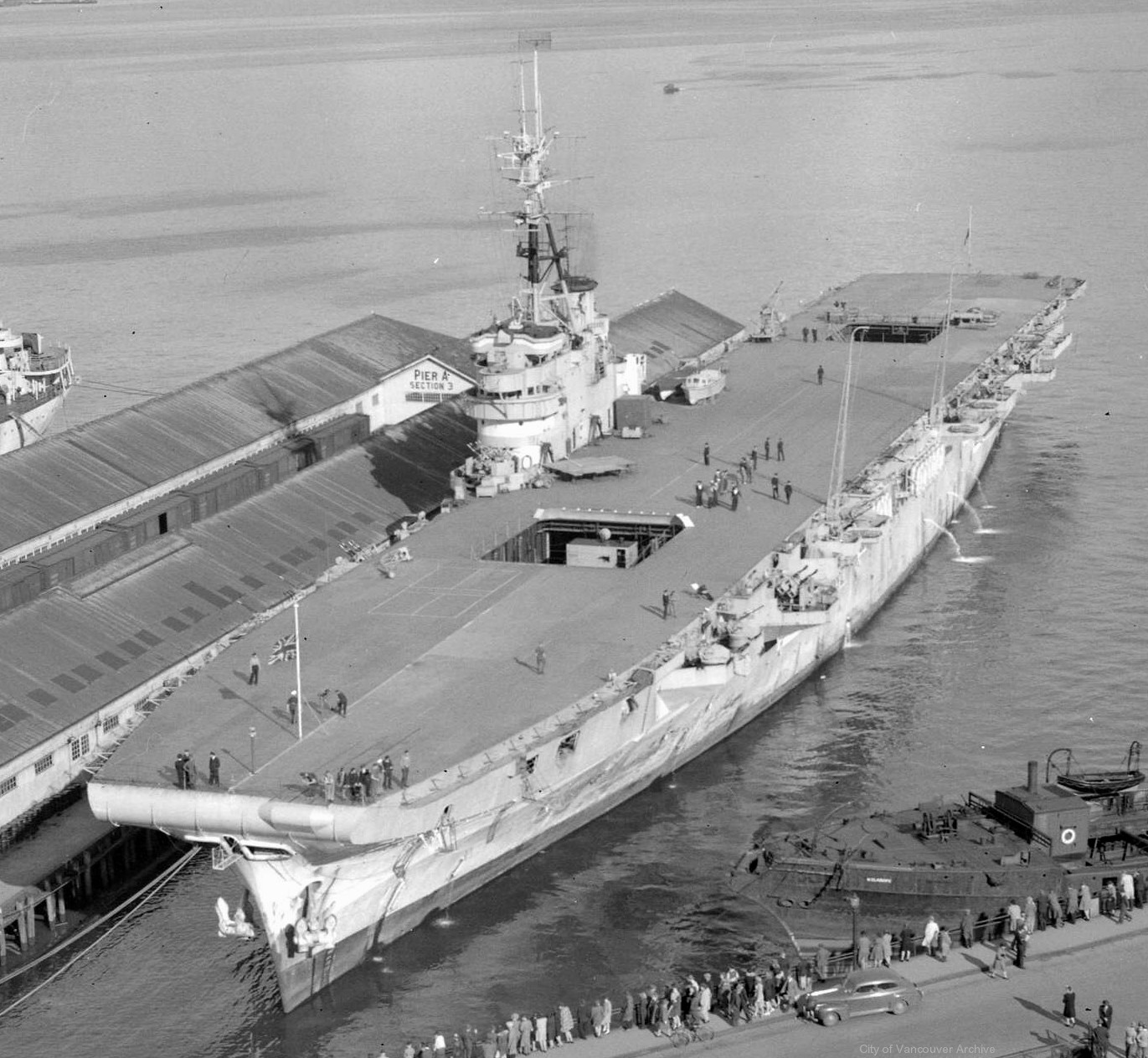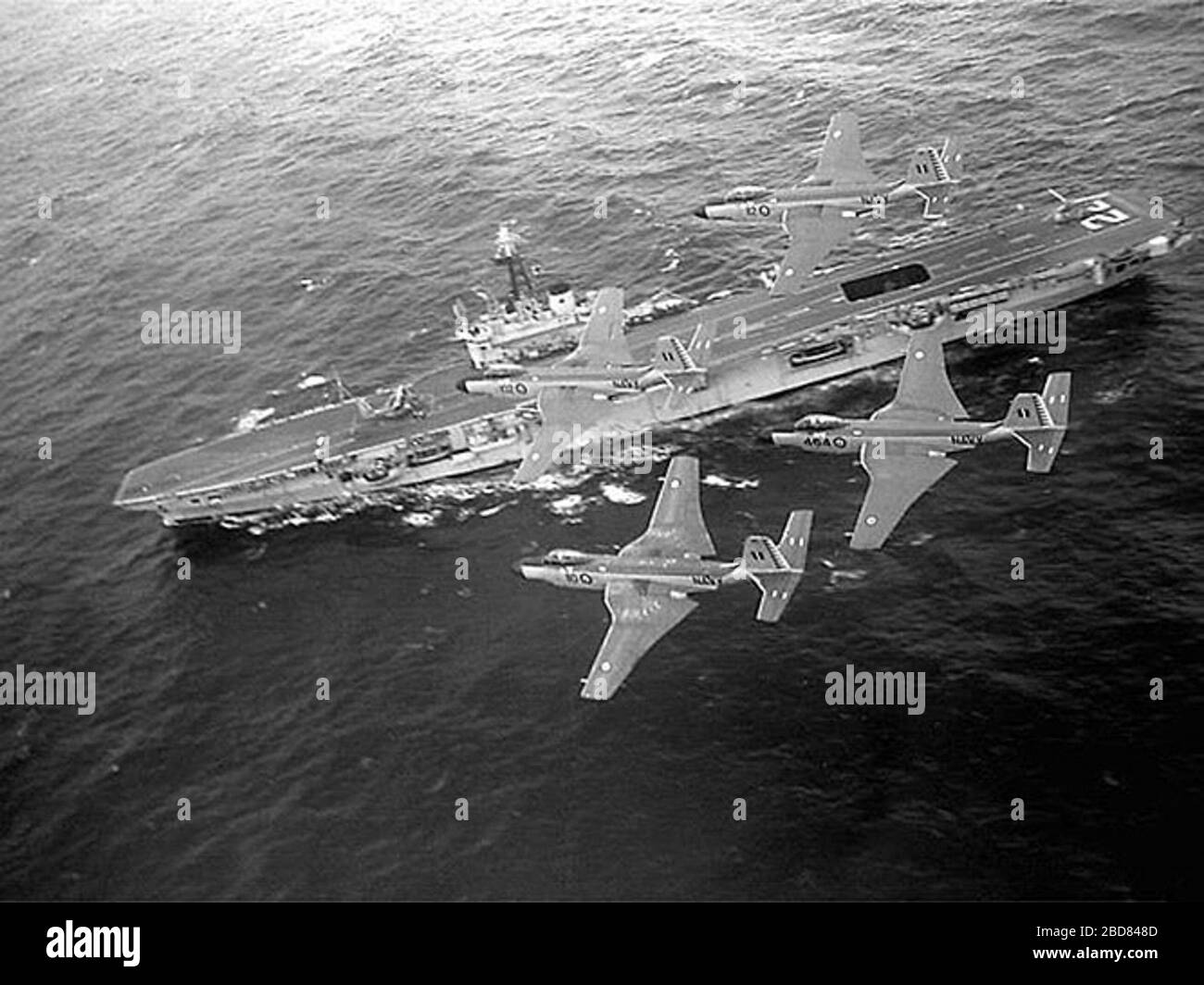Canadian Aircraft Carrier - HMCS Magnifict (CVL 21) is a Majestic-class light aircraft carrier that served with the Royal Canadian Navy from 1948 to 1957. Originally commissioned by the Royal Navy during World War II, the Royal Canadian Navy acquired Magnifict while it waited for another aircraft carrier to be completed, and she was decommissioned in 1948, replacing HMCS Warrior, which was on lease to the RN for two years.
Magnifict was commonly known as Maggie while in Canadian service. Canada received the HMCS Bonavture in 1956 and the Magnifict returned to the UK in 1956, where she remained until scrapped in 1965.
Canadian Aircraft Carrier

Designs in 1942 The light fleet was divided into the initial T-class Colossus ships, followed by five Majestic-class ships, which underwent some design changes to accommodate larger and heavier aircraft. These changes reduced the weight of the gasoline and fuel tanks, reducing them to 75,000 gallons to compensate for the increased weight due to deck strength.
Every Single Aircraft Carrier In The World
Operate aircraft weighing up to 20,000 lb (9,100 kg). Other improvements over the Colossus class included larger airlift equipment (54 x 34 ft, 16 m x 10 m) and interior improvements for survival and accommodation purposes.
The vessel is 698 ft (212.8 m) long with an 80 ft (24.4 m) beam and a 25 ft (7.6 m) draft.
The ship was powered by four three-drum Admiralty boilers. This powered two 40,000 horsepower (30,000 kilowatts) Parsons steam turbines that drove two shafts.
Majestic-class carriers are equipped with Type 281, Type 293 and two Type 277 radar installations. The ship has 1,100 supplies, including an aviation group.
Us Aircraft Carriers Conduct Military Drills In Asia
The third ship of the Majestic class, Magnifict, was ordered on 16 October 1942. The order was awarded to Harland and Wolff of Belfast, who also built the Colossus Glory and Warrior class ships.
Construction of the Magnificent began on 29 July 1943, yard number 1228, and she was launched on 16 November 1944.
Grandeur operates both fixed-wing and rotary-wing aircraft. In preparation for joining the Royal Canadian Navy, the two squadrons previously assigned to the Warriors, 803 and 825, were designated as the 19th Air Group and carried Sea Furies and Firefly IVs. The 883rd (Fighter) and 826th (Torpedo Bomber/Scout) Squadrons re-formed the 18th Carrier Aviation Group. Seafires and older model Fireflies were brought on board.

In 1950, the Canadian government purchased 75 Grumman TBF Avgers from the US Navy for the Magnificta. They are intended to replace the Fireflies of 825 and 826 Squadrons.
On This Date: December 2019
In May 1951, the squadrons were changed to the 18th Air Group and the 30th Squadron, the 883rd Squadron was changed to the 871st Squadron, and the 826th Squadron was changed to the 881st Squadron. The 19th Air Group was changed to the 31st (Support) Air Group, and the squadrons were changed from 803 and 825 to 870 and 880.
In 1955, RCN purchased a Sikorsky H04S helicopter and fitted it with a Dunking sonar. The first squadron, HS-50, went aboard Magnifict in July 1955.
In September 1955, the Canadian Navy began using U.S. Navy-style markings on its air units. VF-871 consisted of Sea Furies and VS-881 consisted of Avgers. In February 1956, Magnifict carried a second unit of HU-21 helicopters.
In May 1944, the Royal Canadian Navy (RCN) intended to increase its fleet in proportion to the size of the ships for a greater role in the Pacific theater.
Uss Harry S. Truman Cvn 75 Custom Personalized Photo Navy
In October, the RCN offered to exchange the RCN-managed US frigate, the operational Puncher, and the badly damaged (not returned to service) Nabob, with the aim of obtaining a larger aircraft carrier from the Royal Navy.
Six Majestic-class ships were deemed to be beyond the Royal Navy's plans and three state-of-the-art ships were offered for loan.
In January 1945, RCN negotiated a loan for the two ships Warrior (Colossus class) and Magnifict, with an option to purchase them at a later date.

Since the Warrior was almost complete, hastily built for service in the Pacific theater, not for fighting in colder climates,
Canadian Aircraft Carrier, The Magnificent, Is Shown Here In Dry Dock At Saint John, N
She was the first of two to be transferred to the RCN and was commissioned as an HMCS fighter on 24 January 1946. She officially joined the Canadian Atlantic Fleet on the 23rd.
But it requires extra work to eliminate builder errors. The ship encountered equipment failure to heat up while operating in the cold waters of the North Atlantic off eastern Canada in 1946 and was transferred to the Canadian Pacific Fleet, arriving at Esquimalt, British Columbia in December 1946. During the January 1947 refit, the RCN examined the overall effect of reducing defense restrictions and crews, and concluded that they could not operate two aircraft carriers simultaneously. When the Magnifict was ready, negotiations began to return the fighter, which the RCN deemed unfit for service due to lack of heating. As the Magnifict is still under construction, all preparations have been included to make her fully operational in colder climates. The ship was commissioned into the Royal Canadian Navy on March 21, 1948,
Two days later, Warrior was decommissioned as an RCN ship and returned to the RN, who commissioned her to the RN a few months later.
Upon arrival in Halifax on June 1, 1948, Magnifict began construction. She lost two planes in training.
Uk Carrier To Hold Naval Drills With Japan In Asian Waters
The aircraft carrier sailed with destroyers Nootka and Haida to the Ungava Peninsula, Quebec, for a practice cruise and a stop in Wakeham Bay, Quebec. From there, the two destroyers left the carrier and sailed north, becoming the first RCN warships to enter Hudson Bay.
In January 1949, the Magnifict sailed for the UK carrying Firefly Vs to replace 825 Squadron's Firefly IVs. After the aircraft carrier returned, the 825th Squadron disembarked at Dartmouth, Nova Scotia, and the 803rd, 883rd, and 826th Squadrons began their training cruise to the Caribbean.
On March 20, 1949, during a fleet maneuver in the Caribbean, 32 aircraft operators aboard the Magnifita briefly refused an order to report to an early morning cleaning station in protest of various grievances. The captain acted very sensitively to defuse the crisis, engaged in informal discussions with the disgruntled crew and was careful to use the word "incident" rather than "mutiny", which could have serious legal consequences for those handling it .
Almost simultaneously, similar incidents occurred at Cresct in Nanjing, China, and Athabaskan in Manzanillo, Colima, Mexico, where the captains of both behaved similarly to Magnifict.
U.s. Navy Carrier Group Enters Sea Of Japan For First Time In 5 Years
She ran aground in Mouton, Nova Scotia following an accident in the Caribbean in June 1949. With the help of destroyers, the Maggie was salvaged and shipped to St. John's for repairs.
After the outbreak of the Korean War, the "Magnificent" was decommissioned from the theater on the grounds that it had assumed NATO duties.
In September 1952, the carrier took part in the large NATO exercise Mainbrace and again in 1953 in the Mariner exercise.
16 aircraft (8 Sea Furies and 8 Avgers) participated in the overflight. Maggie refitted in Portsmouth, March 1954.
Sailors Man The Rails On The Flight Deck Aboard The Aircraft Carrier Uss Dwight D. Eisenhower (cvn 69)(ike). Ike Is Conducting A Port Visit To Halifax, Nova Scotia, As Part Of The
In 1955, Magnifict sailed to the Caribbean for training exercises with the US and Royal Navy, accompanied by Micmac and Haida, then sailed to Portsmouth before returning to Canada.
In early September, under the escort of the USS Mi'kmak, USS Haida and USS Huron, the aircraft carrier visited Europe for the second time, visited ports several times, and participated in two NATO naval exercises.
On October 10 of the same year, the TBF Avger made its last fixed-wing flight aboard the Magnifict.

On November 6, 1956, Lolt, the St. Louis government, decided to join the United Nations Contingency Force and agreed to send ground troops to Egypt.
Navy Opens Investigation After 4 Deaths By Suicide Among Aircraft Carrier Crew
The Magnifict, which was selected to deliver rice and supplies to Egypt, was withdrawn from training exercises in November.
The original plan was to carry Canada's Quays Rifle Corps, but that order was canceled in December. Magnifict in Halifax until this month's d
Headed to Egypt with 4 Royal Canadian Air Force de Havilland Canada DHC-3 Otters and an H04S helicopter.
She arrived in Port Said in early January 1957. It was her last mission, ferrying most of the Canadian peacekeepers to Egypt, with the vehicle parked on her deck.
Colossus Class Aircraft Carrier
She was replaced in RCN service by Bonavture, another Majestic class Royal Navy ship (HMS Powerful) that was not completed on the day of the war. In 1957 it was returned to the RN and kept pending its liquidation. Magnifict couldn't handle the modern jets of the time, causing her to go back and replace them. Barry's wavy target and azure horseshoe at the base or Wyvern's wings showing the red of the Canadian crown on a field
HMCS Bonavture is a Majesty-class aircraft carrier, the third and final aircraft carrier in service with the Canadian Navy. The aircraft carrier was originally commissioned by the Royal Navy during World War II as HMS Powerful. After the war, construction of the ship stopped and did not resume until 1952, this time at
Canadian carrier, canadian navy aircraft carrier, canadian aircraft, army aircraft carrier, lexington aircraft carrier, future canadian aircraft carrier, new canadian aircraft carrier, aircraft carrier san diego, aircraft carrier, aircraft carrier museum ships, midway aircraft carrier, lego navy aircraft carrier
0 Comments